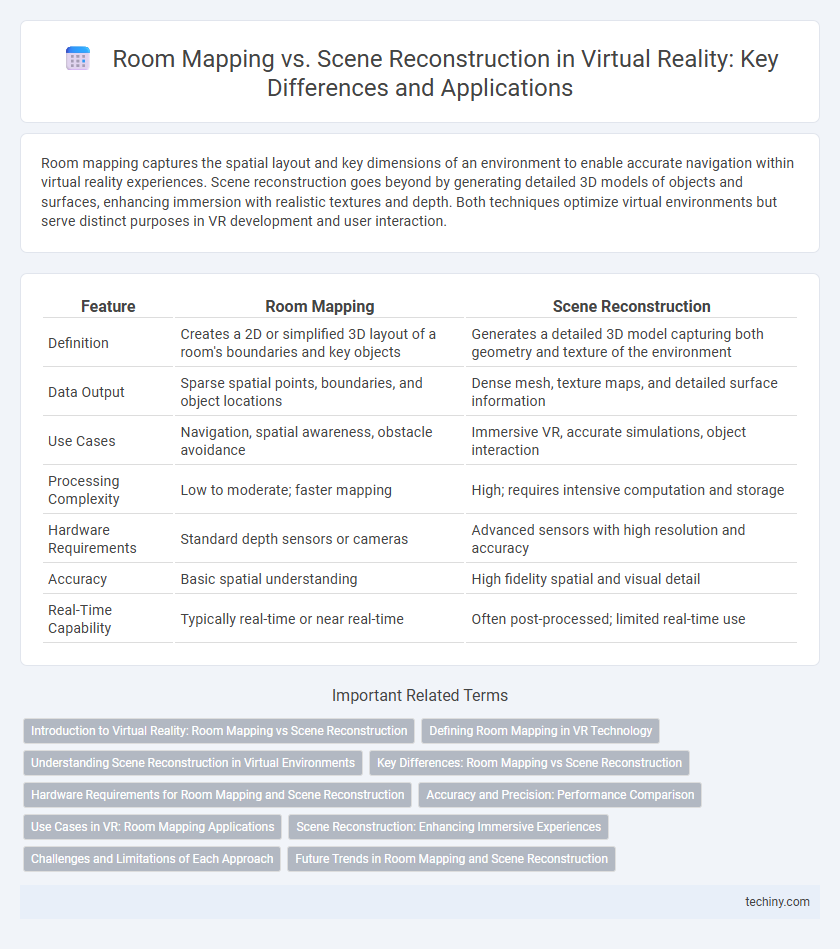Room mapping captures the spatial layout and key dimensions of an environment to enable accurate navigation within virtual reality experiences. Scene reconstruction goes beyond by generating detailed 3D models of objects and surfaces, enhancing immersion with realistic textures and depth. Both techniques optimize virtual environments but serve distinct purposes in VR development and user interaction.
Table of Comparison
| Feature | Room Mapping | Scene Reconstruction |
|---|---|---|
| Definition | Creates a 2D or simplified 3D layout of a room's boundaries and key objects | Generates a detailed 3D model capturing both geometry and texture of the environment |
| Data Output | Sparse spatial points, boundaries, and object locations | Dense mesh, texture maps, and detailed surface information |
| Use Cases | Navigation, spatial awareness, obstacle avoidance | Immersive VR, accurate simulations, object interaction |
| Processing Complexity | Low to moderate; faster mapping | High; requires intensive computation and storage |
| Hardware Requirements | Standard depth sensors or cameras | Advanced sensors with high resolution and accuracy |
| Accuracy | Basic spatial understanding | High fidelity spatial and visual detail |
| Real-Time Capability | Typically real-time or near real-time | Often post-processed; limited real-time use |
Introduction to Virtual Reality: Room Mapping vs Scene Reconstruction
Room mapping captures the physical layout and dimensions of an environment using sensors to create a spatial framework for VR applications. Scene reconstruction goes beyond by generating detailed, textured 3D models of surroundings, enabling immersive and interactive virtual experiences. Both techniques enhance spatial awareness in virtual reality but serve different purposes depending on the level of environmental detail required.
Defining Room Mapping in VR Technology
Room mapping in VR technology involves creating a digital representation of a physical space by scanning and capturing the room's dimensions, layout, and key features using sensors or cameras. This process enables VR systems to understand spatial boundaries and objects within the environment, facilitating accurate user interaction and navigation. Unlike scene reconstruction, which focuses on building detailed 3D models of objects and surfaces, room mapping prioritizes spatial awareness and boundary detection for immersive experiences.
Understanding Scene Reconstruction in Virtual Environments
Scene reconstruction in virtual environments involves creating detailed 3D models of physical spaces by capturing geometric and textural information, enabling immersive and interactive experiences. Unlike room mapping, which primarily identifies spatial boundaries and basic layouts, scene reconstruction provides a comprehensive representation including object surfaces, lighting, and spatial relationships. This enhanced understanding allows VR systems to simulate realistic interactions and dynamic environments with high accuracy.
Key Differences: Room Mapping vs Scene Reconstruction
Room mapping in virtual reality involves creating a simplified 2D or 3D layout of the physical environment to enable accurate user navigation and object placement, prioritizing spatial boundaries and dimensions. Scene reconstruction generates detailed 3D models with textures and depth information, offering immersive visuals and environment interaction through point clouds or mesh data. Key differences lie in their data complexity and purpose: room mapping focuses on functional spatial awareness, while scene reconstruction delivers comprehensive, photorealistic environment representations.
Hardware Requirements for Room Mapping and Scene Reconstruction
Room mapping in virtual reality typically relies on sensors like LiDAR or depth cameras integrated into devices such as the Microsoft HoloLens or Oculus Quest, requiring moderate processing power to capture spatial layouts quickly. Scene reconstruction demands more advanced hardware, including high-resolution RGB-D cameras and powerful GPUs for detailed 3D model generation and real-time rendering. The hardware for scene reconstruction emphasizes computational capacity to manage complex data processing, while room mapping hardware focuses on efficient, real-time spatial awareness with less intensive computing resources.
Accuracy and Precision: Performance Comparison
Room mapping in virtual reality offers faster spatial awareness by generating simplified floor plans, while scene reconstruction delivers higher accuracy and precision through detailed 3D models capturing textures and depth. The precision of scene reconstruction enhances immersive experiences by enabling realistic object interactions and environmental understanding. Room mapping's lower computational demand suits real-time applications, whereas scene reconstruction's detailed accuracy benefits simulations requiring exact spatial data.
Use Cases in VR: Room Mapping Applications
Room mapping in VR enables precise spatial awareness by generating detailed 2D floor plans, ideal for applications like indoor navigation, virtual real estate tours, and asset management. Scene reconstruction creates fully textured 3D models, supporting immersive experiences such as architectural visualization, detailed environment simulation, and interactive training scenarios. Leveraging room mapping enhances VR's capability to accurately represent physical spaces, improving user interaction in confined environments and real-time spatial analysis.
Scene Reconstruction: Enhancing Immersive Experiences
Scene reconstruction in virtual reality creates a detailed 3D model of the environment by capturing geometry, textures, and spatial relationships, enabling more immersive and interactive experiences compared to basic room mapping. This technology leverages advanced sensors and algorithms to rebuild scenes in real-time, allowing for accurate object placement and dynamic interaction within the virtual space. Enhanced scene reconstruction improves user presence and realism by providing environment-aware content, crucial for applications in gaming, training simulations, and virtual tourism.
Challenges and Limitations of Each Approach
Room mapping in virtual reality faces challenges with accurately capturing dynamic environments and occluded areas, often resulting in incomplete spatial data. Scene reconstruction struggles with high computational demands and real-time processing constraints, limiting its ability to provide seamless user experiences. Both approaches require advanced sensor technologies and robust algorithms to address issues like noise, latency, and environmental variability.
Future Trends in Room Mapping and Scene Reconstruction
Advancements in room mapping and scene reconstruction are driving immersive VR environments with increased accuracy and real-time processing capabilities. Future trends emphasize AI-powered algorithms optimizing spatial data integration, enabling dynamic updates and seamless user interaction within virtual spaces. Enhanced sensor fusion techniques and 5G connectivity promise faster, more precise virtual world generation, elevating the realism and responsiveness of VR experiences.
Room mapping vs Scene reconstruction Infographic

 techiny.com
techiny.com